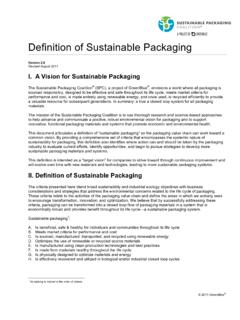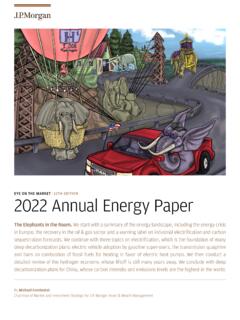Transcription of LESSON PLAN 2.9 Renewable and Non-Renewable Energy
1 LESSON PLAN: LESSON Renewable AND Non-Renewable Energy Page 1 of 10 FORMS OF Energy LESSON PLAN Renewable and Non-Renewable Energy This LESSON is designed for 3rd 5th grade students in a variety of school settings (public, private, STEM schools, and home schools) in the seven states served by local power companies and the Tennessee Valley Authority. Community groups (Scouts, 4-H, after school programs, and others) are encouraged to use it as well. This is one LESSON from a three-part series designed to give students an age-appropriate, informed view of Energy .
2 As their understanding of Energy grows, it will enable them to make informed decisions as good citizens or civic leaders. This LESSON plan is suitable for all types of educational settings. Each LESSON can be adapted to meet a variety of class sizes, student skill levels, and time requirements. Setting LESSON Plan Selections Recommended for Use Smaller class size, higher student ability, and /or longer class length The Modeling Section contains teaching content. While in class, students can do Guided Practice, complete the Recommended Item(s) and any additional guided practice items the teachermight select from Other Resources.
3 NOTE: Some LESSON plans do and some do not contain Other Resources. At home or on their own in class, students can do Independent Practice, complete the Recommended Item(s) and any additional independentpractice items the teacher selects from Other Resources (if provided in theplan).Average class size, student ability, and class length The Modeling Section contains teaching content. While in class, students complete Recommended Item(s) from GuidedPractice section. At home or on their own in class, students complete Recommended Item(s) from Independent Practice class size, lower student ability, and/or shorter class length The Modeling Section contains teaching content.
4 At home or on their own in class, students complete Recommended Item(s) from Independent Practice Safety Reminder: Teachers should remind students that electricity is dangerous and that an adult should be present when any recommended activities or worksheets are being completed at home. Always obey instructions on warning labels and ensure one has dry hands when touching electronics or appliances. performance Objectives By the end of this LESSON , students will be able to: Identify, explain, and provide examples of both Renewable and Non-Renewable Energy sources.
5 Discover ways to conserve Energy . Evaluate their families use of Energy . Understand the benefits and disadvantages of using School System Teaching Standards Covered State Science Standards AL GLE 3rd AL GLE 3rd MS 4th KY SC-5-ET-U-2 5th TN SPI andWCS 4thCommon Core Language Arts/Reading MS,TN 4th KY 5th AL 3rdLESSON PLAN: LESSON Renewable AND Non-Renewable Energy Page 2 of 10 I. Anticipatory Set (Attention Grabber) Essential Question How can we be sure to never run out of Energy ? II. Modeling (Concepts to Teach)A natural resource is given by nature and can be used as a source of Energy .
6 A Renewable natural resource is one that can be renewed, or replenished in a reasonable amount of time (in years or a human-life span), once it has been used. Renewable Energy is generated from natural sources (sun, wind, rain, tides, and vegetation) and can be generated again and again when needed. It is generally replenished naturally. For example, trees are a Renewable resource because once a tree is removed and used, a new tree can grow in its place. Additional information is available at LESSON PLAN: LESSON Renewable AND Non-Renewable Energy Page 3 of 10 Types of Renewable Natural Resources Energy The sun s light contains Energy in the form of electromagnetic waves.
7 Usually, when light hitsan object the Energy turns into heat, like the warmth felt while sitting in the sun. But when light hits certain materials, likesilicon, the Energy turns into an electrical current instead, which can then be harnessed for power. This was discoveredearlier in history when Einstein explained the Photoelectric Effect and proposed that light can act like a particle, as wellas a wave. For more information, see WORKING SCHEME OF HOW SOLAR WORKS Image source: PLAN: LESSON Renewable AND Non-Renewable Energy Page 4 of 10 Energy Hydroelectric plants use falling water from a dam to turn the turbine of a generator.
8 The generator then produces electricity. , Energy from the Greek words geo, or earth, and therme, meaning heat. Deep inside the Earth lies hot water and steam that can be used to heat homes and businesses and generate electricity cleanly and efficiently. The steam is used to drive turbines of a generator and the generator produces electricity. PLAN: LESSON Renewable AND Non-Renewable Energy Page 5 of 10 Energy The Energy of the wind is transferred to the turbines of the generator and the generator produces electricity. Wind turbines use the momentum of moving air to quietly turn large blades that are attached to the shaft of an efficient electric generator.
9 Energy Biomass is matter usually thought of as garbage. This matter includes things like leaves, tree branches, leftover crops, wood chips, and bark. It can even include animal manure and old PLAN: LESSON Renewable AND Non-Renewable Energy Page 6 of 10 The biomass is then placed into a furnace and burned, or the methane gas in a liquid or gaseous state from algae or rotting / decomposing materials is captured. The heat generated is used to boil water. The steam from the boiling water is used to turn turbines and generators to produce electricity.
10 A Non-Renewable natural resource is one that has specific conditions that made them (like fossilized plant matter converting into coal), and can take many generations to reproduce. Sometimes the conditions are not likely to occur again so they are limited in supply and once used cannot be re-generated within a short span of time. Non-Renewable sources exist in the form of natural gas, oil, and coal. For example, fossil fuels have been percolating beneath the Earth for hundreds of millions of years, and once they re gone, they re going to take millions more years to replenish.






